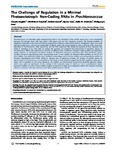The Challenge of Regulation in a Minimal Photoautotroph: Non-Coding RNAs in Prochlorococcus
| dc.contributor.author | Steglich, C | |
| dc.contributor.author | Futschik, Matthias | |
| dc.contributor.author | Lindell, D | |
| dc.contributor.author | Voss, B | |
| dc.contributor.author | Chisholm, SW | |
| dc.contributor.author | Hess, WR | |
| dc.date.accessioned | 2017-02-07T19:49:18Z | |
| dc.date.available | 2017-02-07T19:49:18Z | |
| dc.date.issued | 2008-08 | |
| dc.identifier.issn | 1553-7390 | |
| dc.identifier.issn | 1553-7404 | |
| dc.identifier.other | ARTN e1000173 | |
| dc.identifier.uri | http://hdl.handle.net/10026.1/8406 | |
| dc.description.abstract |
Prochlorococcus, an extremely small cyanobacterium that is very abundant in the world's oceans, has a very streamlined genome. On average, these cells have about 2,000 genes and very few regulatory proteins. The limited capability of regulation is thought to be a result of selection imposed by a relatively stable environment in combination with a very small genome. Furthermore, only ten non-coding RNAs (ncRNAs), which play crucial regulatory roles in all forms of life, have been described in Prochlorococcus. Most strains also lack the RNA chaperone Hfq, raising the question of how important this mode of regulation is for these cells. To explore this question, we examined the transcription of intergenic regions of Prochlorococcus MED4 cells subjected to a number of different stress conditions: changes in light qualities and quantities, phage infection, or phosphorus starvation. Analysis of Affymetrix microarray expression data from intergenic regions revealed 276 novel transcriptional units. Among these were 12 new ncRNAs, 24 antisense RNAs (asRNAs), as well as 113 short mRNAs. Two additional ncRNAs were identified by homology, and all 14 new ncRNAs were independently verified by Northern hybridization and 5'RACE. Unlike its reduced suite of regulatory proteins, the number of ncRNAs relative to genome size in Prochlorococcus is comparable to that found in other bacteria, suggesting that RNA regulators likely play a major role in regulation in this group. Moreover, the ncRNAs are concentrated in previously identified genomic islands, which carry genes of significance to the ecology of this organism, many of which are not of cyanobacterial origin. Expression profiles of some of these ncRNAs suggest involvement in light stress adaptation and/or the response to phage infection consistent with their location in the hypervariable genomic islands. | |
| dc.format.extent | e1000173-e1000173 | |
| dc.format.medium | Electronic | |
| dc.language | en | |
| dc.language.iso | eng | |
| dc.publisher | Public Library of Science (PLoS) | |
| dc.subject | DNA, Intergenic | |
| dc.subject | Gene Expression Regulation, Bacterial | |
| dc.subject | Genome, Bacterial | |
| dc.subject | Nucleic Acid Conformation | |
| dc.subject | Open Reading Frames | |
| dc.subject | Phototrophic Processes | |
| dc.subject | Prochlorococcus | |
| dc.subject | RNA, Bacterial | |
| dc.subject | RNA, Untranslated | |
| dc.subject | Transcription, Genetic | |
| dc.title | The Challenge of Regulation in a Minimal Photoautotroph: Non-Coding RNAs in Prochlorococcus | |
| dc.type | journal-article | |
| dc.type | Journal Article | |
| dc.type | Research Support, Non-U.S. Gov't | |
| plymouth.author-url | https://www.webofscience.com/api/gateway?GWVersion=2&SrcApp=PARTNER_APP&SrcAuth=LinksAMR&KeyUT=WOS:000260410800009&DestLinkType=FullRecord&DestApp=ALL_WOS&UsrCustomerID=11bb513d99f797142bcfeffcc58ea008 | |
| plymouth.issue | 8 | |
| plymouth.volume | 4 | |
| plymouth.publication-status | Published online | |
| plymouth.journal | PLoS Genetics | |
| dc.identifier.doi | 10.1371/journal.pgen.1000173 | |
| plymouth.organisational-group | /Plymouth | |
| plymouth.organisational-group | /Plymouth/Faculty of Health | |
| plymouth.organisational-group | /Plymouth/Users by role | |
| dc.publisher.place | United States | |
| dcterms.dateAccepted | 2008-07-17 | |
| dc.identifier.eissn | 1553-7404 | |
| dc.rights.embargoperiod | Not known | |
| rioxxterms.versionofrecord | 10.1371/journal.pgen.1000173 | |
| rioxxterms.licenseref.uri | http://www.rioxx.net/licenses/all-rights-reserved | |
| rioxxterms.licenseref.startdate | 2008-08-29 | |
| rioxxterms.type | Journal Article/Review |


